Don’t start exploring Russian cuisine with kholodets. That is if you are willing to enjoy Russian food. Start with something familiar like pelmeni, Russian-style dumplings, or soup… you’ve had soups before, right? Don’t dive into Russian food head first by trying the one thing most foreigners find weird and, frankly, disgusting. Kholodets, as people like to say about strange foods, is an acquired taste.
Which is true. The only way you are going to enjoy wobbly meat jelly is if you repeatedly had it for all major celebrations starting from that innocent age when you couldn’t understand the meaning of the word “kholodets”, let alone what ingredients go into it. And even then, there are plenty of Russians who hate it.
My mom poetically describes the ingredients of kholodets as “ushi, gorlo, nos; siski, piski, hvost”. In my best attempt to translate this masterpiece, I came up with “ears, nose, and tits; throats, tails, and private bits”. Kholodets recipe calls for all the body parts that are usually thrown out as too revolting in the capitalist world, but are the primary source of protein and energy of the less fortunate.
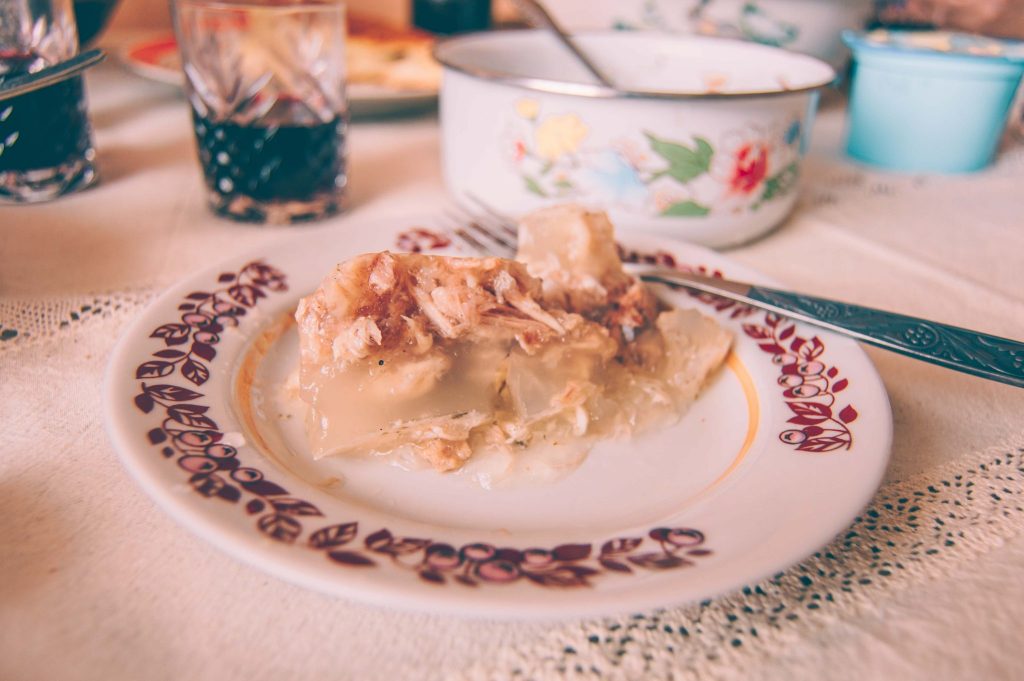
Kholodets, Studen, and Zalivnoye
The fact that it doesn’t require a good or expensive cut of meat made kholodets available to people from all kinds of backgrounds. It has been around for a few centuries, present on the tables of both peasants and boyars. Although back in the day the dish was called studen.
In the XIX century, the word “kholodets” referred to a cold fruit jelly, usually made of apples as they are full of pectin, a natural thickening agent. Today, the word kholodets completely lost its original meaning and is used interchangeably with the word studen. To rephrase Shakespeare’s famous quote, kholodets by any other name would taste as weird.

A piece of kholodets served with mustard.
Apart from kholodets and studen, there’s also zalivnoye which is as strange and wobbly, but slightly different in preparation. You see, kholodets has always been quite simple, unsophisticated — grayish jelly with bits of meat inside. When Russian cuisine turns towards European trends with French chefs coming over and bringing their techniques in the end of XIX century, kholodets goes through a make-over.
The stock was clarified with the use of egg whites and occasionally caviar. Slices of meat and beautifully carved eggs and vegetables were set inside jelly to make the dish look more appetizing. Thus, kholodets turned into galantine (French for gelatin), or as we call it in Russia, zalivnoe.
Zalivnoe can be made of meat, as well as fish or solely vegetables. While galantine and zalivnoye referred to the same dish, zalivnoye was a regional and more colloquial variation of the name.
One of the biggest differences between kholodets/studen and galantine/zalivnoye is that the latter is made with gelatin to help it set, while the former is prepared with no additional gelatin whatsoever.

Chicken feet, chicken necks and ham hocks washed and cleaned before making kholodets.
The Magic of Connective Tissue
The meat jello that is kholodets doesn’t require any added gelatin. Cooking is magic, and kholodets proves it. Animal parts with a lot of connective tissue like chicken feet, beef tails, and pig trotters contain collagen. When you boil these parts for a long time, collagen breaks down to produce gelatin naturally.
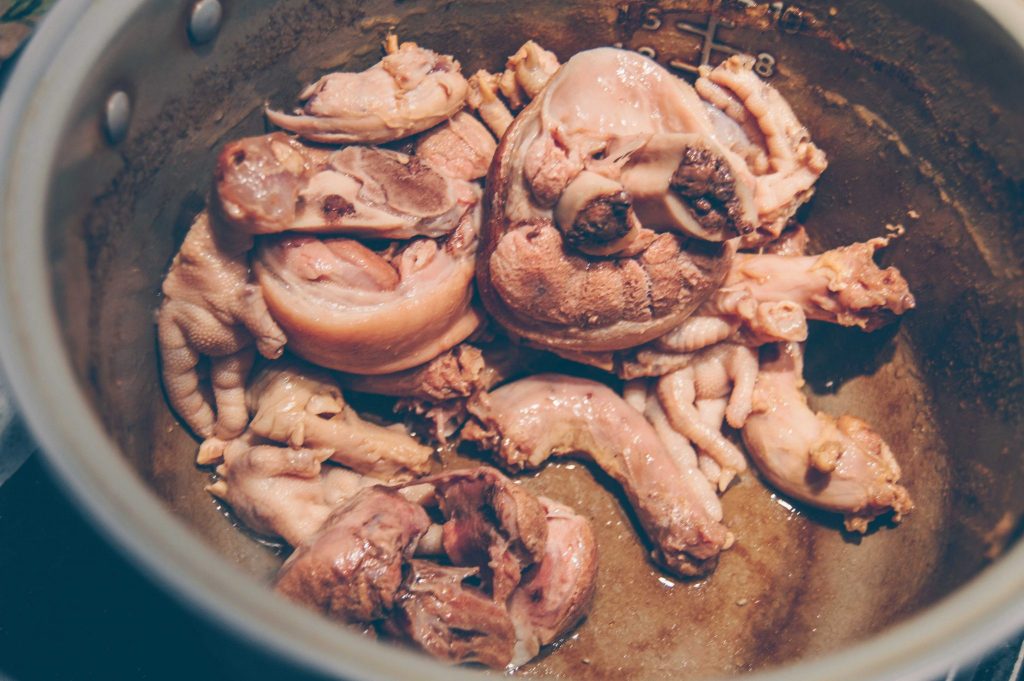
The chicken feet, necks, and ham hocks after being boiled for five hours.
Basic Rules of Cooking Kholodets
- Choose the right type of meat. Don’t try to make a fancy kholodets of boneless chicken breast and sirloin. First of all, that’s not what kholodets is about. Second of all, it simply won’t set. As I mentioned above, you need parts with lots of connective tissue for kholodets to set without added gelatin. Make sure to include either chicken feet or beef tails or pig trotters.
- When using leftover parts of meat, clean them properly using a brush. I mean it’s feet you are going to eat. Seriously, clean them well.
- Some recommend to leave the meat covered with cold water for a few hours if you are using beef. It will help to achieve transparent color of the stock. I haven’t used beef in the recipe below, so I skipped this step.
- The water in a pan should cover the meat fully with additional 2-3 cm (1 inch) on top. Boil over very low flame for 5-6 hours until meat falls off the bones. Do not cover the pan with a lid. Condensate appears on the inside of the lid and the water drops back into stock. Remove foam every so often from the surface of the stock to make sure it is clear. Do not add any more water after you started cooking the stock. It will make the stock less concentrated and it won’t set.
- You can use multicooker instead of a regular pan; it will make your life a lot easier. Just set the timer and go do something more important, like binge-watch a season of Office. You won’t need to remove foam or worry about condensate.
- Add salt at the very end, about 30 min prior to turning off the fire. As water evaporates over 5-6 hours of cooking and the stock becomes more concentrated, it is easy to oversalt it if you add salt in the beginning.
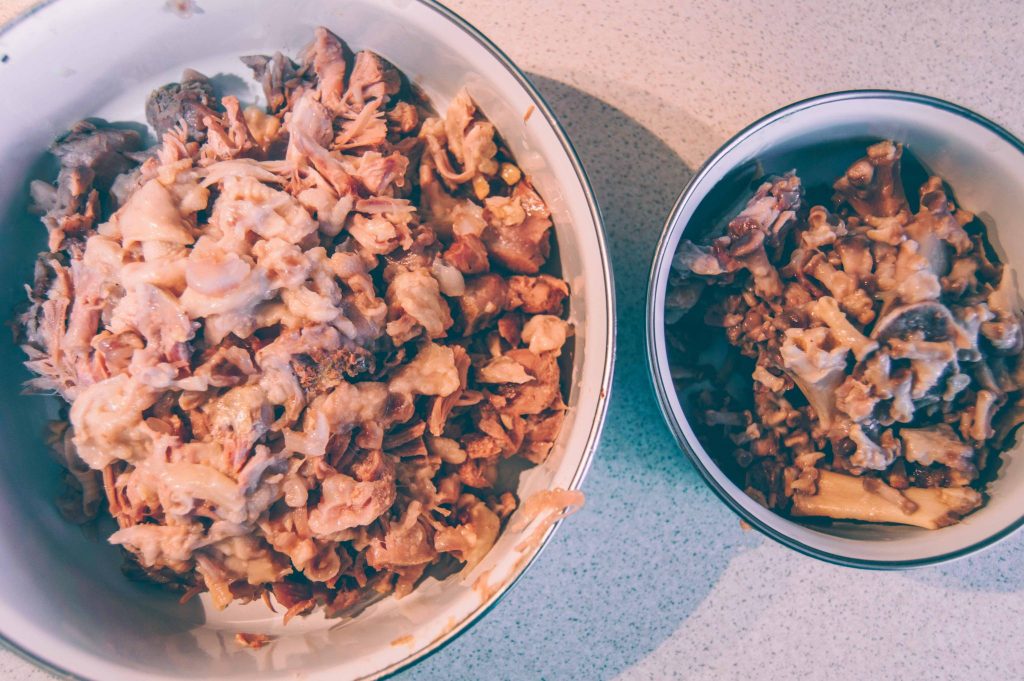
Meat separated from the bones.
The Horror Stories
If you’ve ever made kholodets, chances are you have a horror story. Mine is not too bad. A while ago, when I was younger and, as my dad likes to say, “didn’t understand anything about sausage leftovers” (I’ll need to write a post to explain this one), my mom decided to prepare kholodets for New Year’s eve. I tried to avoid the kitchen, cringed, and made theatrically exaggerated vomiting noises. I like kholodets, though, I am just not very fond of the cooking process. When the clock struck twelve, who do you think found a chicken nail in his kholodets portion at the New Year table?
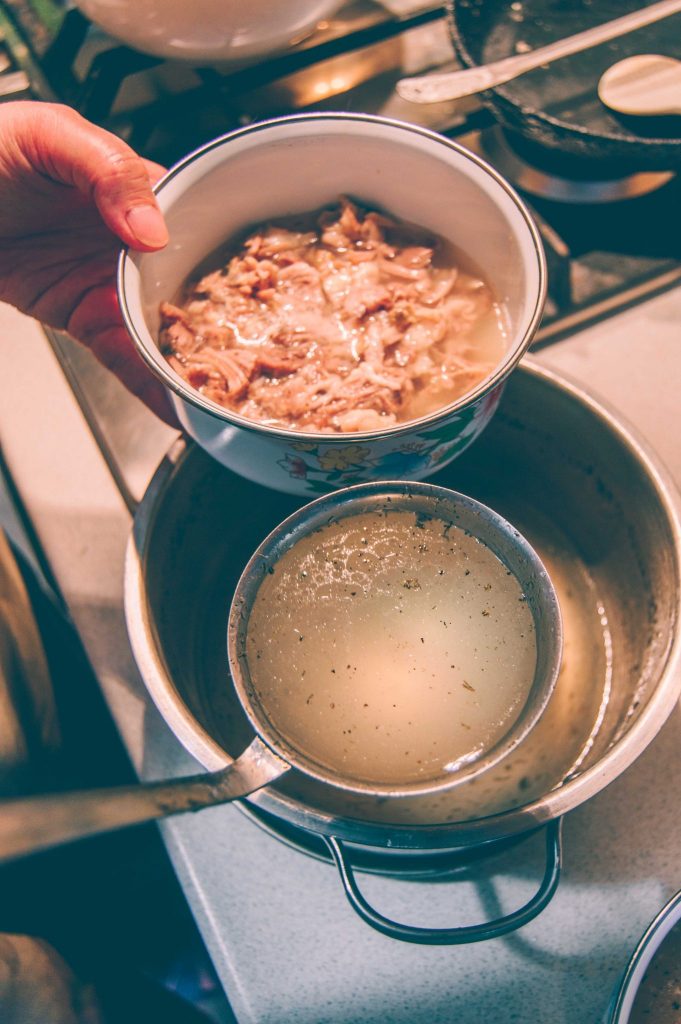
Adding stock back into a bowl with meat pieces.
My story pales beside that of my friend Zhenya’s. Zhenya grew up in a small Russian town of Kamensk-Uralsky where her family owned a house, a garden, and a few farm animals like chickens and sheep. I vaguely remembered that Zhenya told me the kholodets story when both of us were in University. Almost eight years later I wrote to her asking to refresh my memory.
“Zhenya, remember in Uni you told me this crazy story how you and your sister cooked a kholodets?”
“No… can’t remember any crazy story… but hey! Once we made kholodets of sheep heads and we had to brush their teeth to make sure kholodets turns out clear and tasty!”
I doubled down with laughter upon reading her message. Nah… nothing crazy… just brushing dead sheep’s teeth as you always do.
But that is not the end of story. Because the sheep head is particularly rich — let’s put it that way — in nutrients and you have to stay nearby while it boils to remove access foam, Zhenya’s sister got nauseated and had to go out of the house to vomit every so often, then come back to continue boiling the head. Needless to say, neither Zhenya nor her sister ate the khlodets at that dinner, but all the guests were impressed by the taste and quality of their creation.
Well, I think I did my best of scaring you off cooking this Russian delicacy, but if you are still contemplating the idea, there’s a kholodets recipe below. It’s best to cook kholodets in winter — it’s a common dish on New Year tables across Russia. Serve it with mustard or horseradish, in other words, with something that’ll make you cry. Because after cleaning pig trotters with a brush and removing nails from chicken feet with your own hands, you have to cry, if only one tear of joy for having accomplished it.
Russian Kholodets Recipe

Russian Kholodets
Russian meat aspic
Ingredients
- 6 chicken necks
- 12 chicken feet (300g)
- 2 ham hocks
- 2 liters of water (approximately)
- Salt
- Black peppercorns
- Bayleaf
- 5 cloves of garlic
Instructions
-
Wash all the meats properly using a brush and place them in a pan.
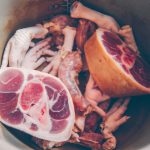
-
Add water to the pan to cover the meats with 2-3 cm (1 inch) to spare.
-
Place the pan over very low heat and leave to simmer for 5-6 hours. Do not cover with the lid. From time to time remove the foam that forms on the surface. If you are using a multicooker, simply set it to simmer for 5-6 hours, nothing else to be done. Do not add any more water.

-
30 minutes prior to switching off the heat, add salt to taste, black peppercorns, and bayleaf.
-
Once the meat is soft and falls off the bone, turn the heat off. Take the meat out of the stock and let it cool.

-
Remove bayleaf and peppercorns from the stock and strain it through gauze. It will help achieve clear stock that is necessary for kholodets to be transparent.

-
Separate the meat from the bones carefully. Make sure to remove all the smallest bones and the nails from chicken feet. No-one wants to find them in their kholodets, like I once did.

-
Peel garlic cloves and grate them. Mix the garlic with meat pieces.
-
Arrange pieces of meat in a dish (for this amount of meat we used three dishes). Then pour the stock over meat pieces.

-
Place in the middle section of the fridge to set overnight.
-
Serve with mustard or horseradish.
Pin for Later:
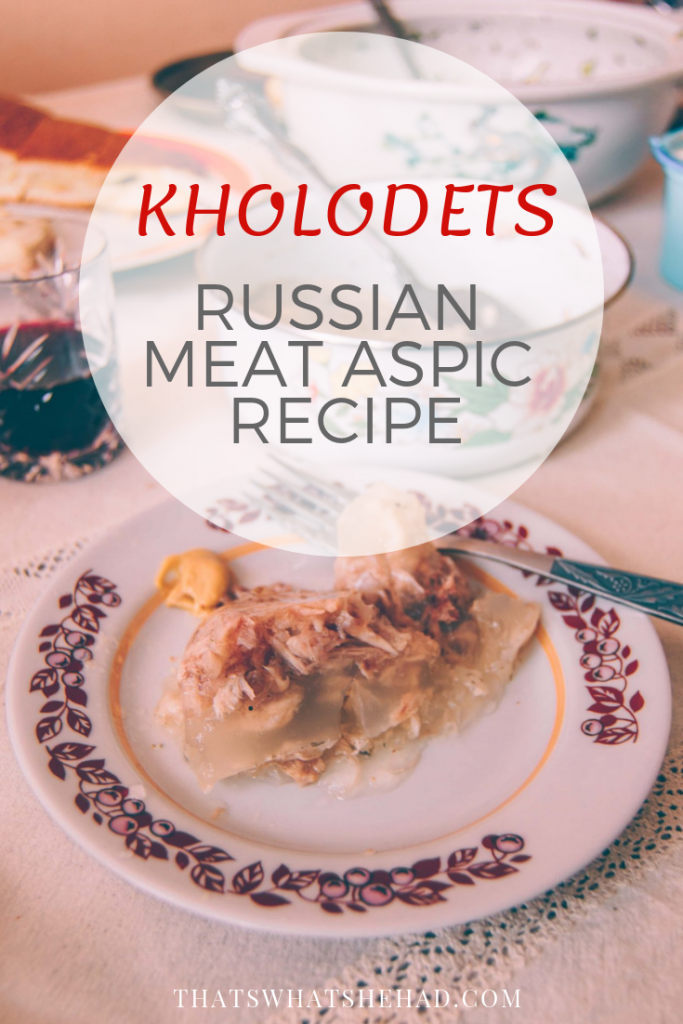




Hey Imran! Don’t think I am going to make kholodets any time soon (given how laborious the process is), but maybe if my mom makes it around New Year we can try that 🙂 Thank you for the tips!
I don’t think so 🙂 It’s such a messy affair, I need to summon courage for it 😀
Can i send you a pressure cooker so you can make it in like 30 minutes.
sometimes time is an ingredient!